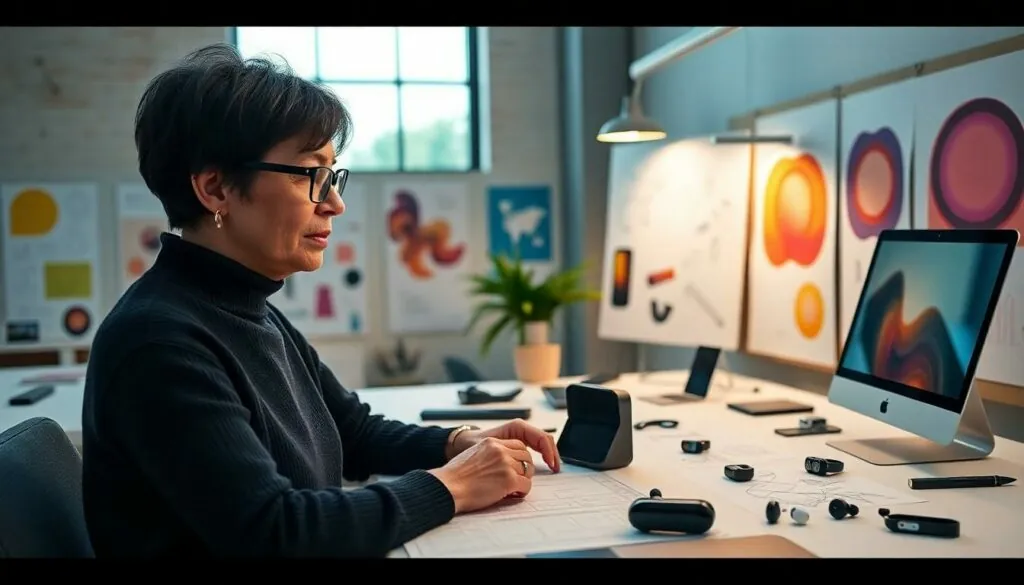In a world where gadgets seem to multiply faster than rabbits, consumer electronics designers are the unsung heroes behind the screens we can’t live without. These creative masterminds blend art and science, turning wild ideas into sleek devices that make life just a bit easier—and a lot more fun. Ever wondered who decided your phone should be a pocket-sized computer? Yep, it’s these folks.
With their keen eye for aesthetics and relentless pursuit of innovation, they juggle user needs and technological trends like a circus performer with flaming torches. From the latest smartwatches to those irresistible wireless earbuds, consumer electronics designers shape the way we interact with technology. So next time you marvel at your favorite gadget, remember the brilliant minds who made it all possible. They’re not just designing products; they’re crafting the future, one pixel at a time.
Table of Contents
ToggleOverview of Consumer Electronics Designers
Consumer electronics designers play a pivotal role in the development of modern gadgets. They combine aesthetics with functionality, resulting in devices that enhance user experience. Creating products like smartwatches and wireless earbuds requires a keen understanding of materials, ergonomics, and technology.
Designers analyze user feedback to inform their design decisions. This feedback loop leads to improvements in device usability, ensuring that products meet consumer expectations. They often collaborate with engineers, marketers, and manufacturers to streamline the design process.
Trends in technology influence their work significantly. With rapid advancements, designers adapt to incorporate features such as artificial intelligence, improved battery life, and enhanced connectivity. Innovations like these shape how consumers interact with technology on a daily basis.
Research underlines that effective design can influence sales and brand loyalty. A well-designed product often stands out in a competitive market, making it essential for designers to stay current with industry standards. Following design principles leads to successful product launches and satisfied customers.
Sustainability has become a critical focus in consumer electronics design. Designers now prioritize eco-friendly materials and energy efficiency, reflecting growing consumer preferences for environmentally conscious products. Embracing sustainable practices contributes to a positive brand image and long-term viability.
Ultimately, consumer electronics designers must balance creativity with practicality. Their contributions bridge the gap between cutting-edge technology and everyday usability, making them indispensable in today’s tech-driven landscape.
Key Skills of Successful Designers

Successful consumer electronics designers exhibit a range of essential skills that enhance their effectiveness in the industry. These skills empower them to create innovative products that resonate with users.
Technical Proficiency
A solid foundation in engineering is vital for designers. Understanding materials, manufacturing processes, and software tools enables them to develop functional prototypes. Knowledge of coding and electronics also plays a crucial role in ensuring product feasibility. Familiarity with design software like CAD allows for precise modeling. Combined, these competencies facilitate seamless collaboration with engineers and manufacturers, translating concepts into tangible devices.
Design Thinking
Embracing design thinking transforms the approach to problem-solving. Designers prioritize empathy by understanding user needs and challenges. They adopt a holistic view, considering aesthetics, functionality, and user experience. Iterative processes enhance solution development, encouraging continuous refinement. By engaging in brainstorming sessions and sketching ideas, designers foster creativity and innovation. This mindset helps create products that not only meet technical requirements but also delight users.
User-Centric Approach
Focusing on user experience sets successful designers apart. They gather insights through user research and feedback, allowing for informed design decisions. Effective usability testing identifies potential issues before product launch ensuring consumer satisfaction. Designers often create personas to represent target users, guiding the design process. This commitment to user-centricity results in products that enhance everyday life while addressing real-world problems. Engaging directly with users leads to innovative solutions tailored to their specific needs.
Emerging Trends in Consumer Electronics Design
Consumer electronics designers adapt swiftly to new trends, significantly impacting the industry. Sustainability and smart technology are at the forefront of current design strategies.
Sustainability in Design
Sustainability emerges as a pivotal element in modern consumer electronics. Designers prioritize eco-friendly materials, choosing biodegradable plastics and recycled metals for new products. Energy-efficient designs reduce electricity consumption, appealing to environmentally conscious consumers. Incorporating life cycle assessments helps ensure that products minimize environmental impact throughout their entire lifespan. Designers also focus on modular designs, allowing for easier repairs and upgrades, which extend product longevity and reduce waste.
Integration of Smart Technology
Integration of smart technology revolutionizes consumer electronics. Designers implement artificial intelligence features, enhancing device functionality and user experience. Smart sensors improve interactivity, allowing products to adapt to user preferences seamlessly. Voice recognition technology enables hands-free control, making devices more accessible and user-friendly. Greater connectivity through the Internet of Things (IoT) allows products to communicate with one another, creating a cohesive ecosystem that enhances convenience and efficiency. This integration not only fulfills consumer demands but also drives innovation across the industry.
Notable Consumer Electronics Designers
Various designers have significantly influenced the consumer electronics landscape. These individuals demonstrate how innovative design shapes products that enhance everyday experiences.
Case Studies of Influential Designers
Jony Ive transformed Apple’s design philosophy, crafting iconic products like the iPhone and MacBook. His minimalist approach combined aesthetics with functionality, making technology approachable for users. Yves Béhar led the design of the eco-friendly Jawbone UP, emphasizing health tracking while prioritizing sustainability. Known for integrating emotional connection into products, he has influenced how users interact with technology. Dieter Rams of Braun is renowned for his principle of “less, but better,” inspiring countless designers to focus on simplicity and usability in consumer electronics.
Contributions to the Industry
These designers have set standards in quality and innovation. Jony Ive’s work helped establish a brand identity that resonates with consumers, driving loyalty and sales. Yves Béhar’s focus on sustainable design not only highlights environmental concerns but also encourages companies to adopt eco-friendly practices. Dieter Rams advocated for timeless design principles, influencing generations of designers to create products with lasting appeal. Each designer’s contributions foster not only consumer trust but also encourage further advancements in the electronics industry.
Challenges Facing Consumer Electronics Designers
Consumer electronics designers face numerous challenges that impact their work. Adapting to rapid technological changes represents a significant hurdle. New technologies emerge frequently, requiring designers to remain agile and learn new skills quickly. Product life cycles shorten, making it vital for them to innovate continuously. They strive to stay ahead of industry trends, integrating artificial intelligence and enhanced connectivity into their designs.
Balancing functionality and aesthetics also poses a challenge. Designers aim to create products that look good while serving practical purposes. They consider user experience to ensure devices are easy to use yet visually appealing. High-quality materials and smart technology frequently influence design choices, pushing them to align user needs with visual design. Achieving harmony between these elements results in products that resonate with consumers and drive brand loyalty.
Consumer electronics designers play a vital role in shaping the technology that enhances daily life. Their unique ability to blend creativity with technical knowledge leads to innovative products that cater to user needs while embracing sustainability. By staying attuned to trends like smart technology and eco-friendly materials, they not only drive industry standards but also foster consumer loyalty.
As they navigate challenges such as rapid technological advancements and evolving consumer preferences, their commitment to quality and usability remains unwavering. The impact of their work extends beyond mere gadgets; it influences how people interact with technology in meaningful ways. Recognizing the importance of these designers encourages appreciation for the artistry and expertise that define the consumer electronics landscape.




